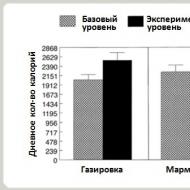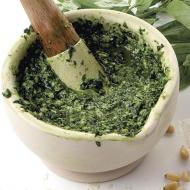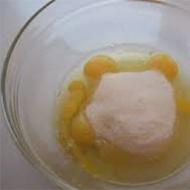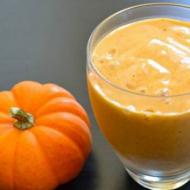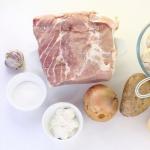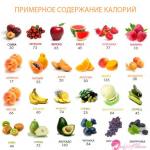
Marshmallow calories per 100 grams of product. Everything you need to know about chocolate covered marshmallows: composition, calorie content, beneficial properties. How many calories are in white marshmallows?
Calories, kcal:
Proteins, g:
Carbohydrates, g:
Marshmallow is an oriental delicacy known since ancient times, which consists of egg whites whipped into a strong foam, powdered sugar and baked apple puree. Currently, marshmallows are made from various fruits, adding agar-agar or other gelling components for density. Classic marshmallows have a white or slightly yellowish color, an elastic consistency of medium softness, and a smooth surface. The taste and aroma of marshmallows is sweet and sour, tender and pleasant. Marshmallow traditionally consists of two hemispheres connected by flat sides. The relief on the surface of the marshmallow is achieved by using various devices for depositing the marshmallow mass into a mold. Various dyes and flavors, berry and fruit juices, coffee extract are added to marshmallows, and the product is coated with chocolate glaze.
The calorie content of marshmallows ranges from 298 to 304 kcal per 100 grams of product, depending on the ingredients and method of preparation.

Composition and beneficial properties of marshmallows
Marshmallows have a short shelf life because they dry out in the open air. Marshmallows should be stored in a cool, dark place; after opening the package, the product should be transferred to a vacuum container or glass container with a sealed lid. The product retains its organoleptic properties for 45 days from the date of production.

Marshmallow in cooking
Marshmallow is usually consumed as an independent dessert, supplemented with a cup or. There are several recipes for cakes, pastries and even salads, which contain marshmallows as an integral part. The sweetness of the delicacy can be complemented by citrus fruits and fresh berries, for example.
The video “Marshmallow. Oriental sweetness in Russian" TV show "Live Healthy".
Especially for
Copying this article in whole or in part is prohibited.
The recipe for this delicacy came to us from Ancient Greece. This confectionery delicacy continues to be popular among those with a sweet tooth today, and the brilliant idea of covering it with a thin layer of chocolate has elevated marshmallows to the highest positions in the world of sweets. Few people will weigh the package before an evening meal, but do not forget that this is a high-calorie and high-carbohydrate product.
The classic composition is whipped applesauce, egg whites, agar-agar. It is believed that such a combination is the most correct, and therefore the most useful, but today it is quite difficult to find this delicacy on sale with such a composition. Chocolate-covered marshmallows are soft and airy, and a layer of dark chocolate pleasantly dilutes the sweet taste.
Benefit
Many experts claim that chocolate-covered marshmallows are one of the most high-calorie foods, as they are saturated with sugar and also contain egg whites, a thickener and chocolate. Therefore, it is better to take a regular one. Dietitians, while studying the product, came to the conclusion that this delicacy is a useful and irreplaceable product. What is its use?
Elements included in the product and their benefits:
. Pectin - removes toxins and heavy metals from the body;
. Agar - contains calcium, iron and iodine;
. Glucose - improves brain performance.
However, it should be remembered that excessive consumption of the product leads to obesity.
Today, one of the most popular manufacturers is Charmel. It has earned its place due to its high quality and minimal content of harmful chemicals. Remember, if you decide to enjoy a cup of tea and a portion of marshmallows, then you are provided with at least 140 Kcal. But on the other hand, it is very difficult to refuse such a delicate sweet delicacy, so be careful and do not eat too much of it, so as not to regret it later.
Calorie content and BZHU
Energy value per 100 grams:
- Proteins - 2 g;
- Fats - 12 g;
- Carbohydrates - 68 g;
- Calorie content - 396 Kcal.
In addition to the main ingredients, the nutritional value of the sweet is influenced by additional additives: sprinkles, nuts, waffles, all kinds of fillings, etc. all this suggests that overuse of this dessert can lead to the addition of extra centimeters to the waist, as well as to serious problems of the digestive system. Therefore, you should not get too carried away with it.
The energy value of one marshmallow in chocolate is 399 Kcal, or (1670 kJ), which is 20% of the total daily value. However, all these indicators are approximate and directly depend on the components of the product. For example, if it contains filling, then the calorie content can increase to 500 Kcal.
During the diet
Those who are losing weight or people who count calories should give up this dessert, since due to the high sugar content it is not able to saturate the body for a long time. After eating one piece, an hour later a person will again feel acute hunger.
But, oddly enough, this delicacy can also be consumed during a diet, replacing high-calorie cakes and pastries with it. You are allowed to eat no more than two pieces per day.
You want to lose weight, so you have to give up sweets - isn’t this torture? But it turns out that you can, with a clear conscience, allow yourself some sweets while on a diet. Don't believe it? Then we will tell you about the calorie content of white marshmallows (1 piece) and why this delicacy does not threaten your figure.
Sweets not prohibited by nutritionists
Marshmallow is not an oriental sweet at all: it was invented by French chefs. One day they decided to put whipped whites in the marshmallow. It is clear that they were not worried about calories at all, but about the taste of the airy dessert. The result exceeded all expectations: the sweetness literally melted in the mouth, which is why it got its name in honor of the light breeze.
The basis of this delicacy is fruit (berry) puree. In order to turn it into marshmallows, sugar is added to it (here are the calories for you!), proteins and some kind of jelly-forming ingredient (gelatin, agar-agar, pectin). You may notice that there is no fat in this recipe. And if you add fructose instead of sugar, marshmallows will turn into a low-calorie product.
How many calories does the treat have?
How many calories are in marshmallows if there is no fat at all? To give an accurate answer to this question, you need to know the weight of one such product. Usually it does not exceed 30-50 g. Different varieties also contain different amounts of calories.
The energy value of marshmallows (per 100 g) is expressed by the following figures:
- white and pink with gelatin – 326 kcal;
- with seaweed – 290 kcal, with pectin – 304 kcal;
- in chocolate – 396-450 kcal;
- vanilla (if agar-agar is used) – 280 kcal; charmel – 375 kcal;
- white with sweetener – 180 kcal;
- in white chocolate or with fillings – 500 kcal.
If condensed milk, marmalade, or cookies are present in marshmallows, then its calorie content becomes much “heavier,” which makes it unsuitable for diets.
Is one marshmallow a lot of calories?
Everything is clear with grams, but still, how many calories will one marshmallow provide you with? The classic “royal” product is held in high esteem among those with a sweet tooth. It does not contain harmful dyes, which is very important for those losing weight. The calorie content of white marshmallows (1 piece) ranges from 100 to 163 kcal if it is prepared with gelatin, or does not exceed 145 kcal if agar-agar is used as a thickener.

Fruit marshmallows, consisting of two halves of different colors, are unusually beautiful and tasty. To give it a soft pink tone, product manufacturers use artificial colors or berry puree (raspberry, strawberry, cherry). The calorie content of white-pink marshmallows (1 piece) based on natural additives is 102 kcal.
Its “brother” with synthetic dyes is more high-calorie and harmful to health: it contains 140 kcal. Marshmallow, yellowish or greenish in color, is made from natural applesauce. It contains 304 kcal per 100 g or 100-150 kcal per piece. Confectioners try in every way to make the delicacy even tastier.
What do they care about how many calories are added to the dessert! They came up with the idea of “dressing” marshmallows in chocolate glaze. This combination made the sweetness even more attractive to the taste buds, but had a very bad effect on its dietary characteristics. This is easy to see if you compare the calorie content of chocolate-covered marshmallows (1 piece) and regular ones. “Clothes” increased caloric intake by more than 60 kcal.
There are as many as 225 of them in one chocolate marshmallow! Naturally, this product is completely unsuitable for those who are trying to get rid of extra pounds. A real masterpiece in the rich marshmallow assortment is the Charmel variety. This confectionery product has a complex composition and is also covered with chocolate glaze. In 100 grams of this delicacy, nutritionists counted 375 kcal, which means that by eating one marshmallow, you will get about 150-180 kcal.
Desserts often contain marshmallow cream. It is light and tasty, and in terms of calorie content it is significantly inferior to butter or custard: 100 g of such filling contains 476 kcal. For comparison: 100 g of sugar - 390 kcal, honey - 320 kcal, chocolate - 560 kcal, marmalade - 306 kcal, marshmallow - 320 kcal.
And the candies “Prunes in Chocolate” (on the packaging of which there is the inscription “low-calorie”) contain 340 kcal. Thus, marshmallows are far from being in first place among other sweet delicacies. In addition, it contains simple carbohydrates (which is important for those who are struggling with weight).
Marshmallow is a confectionery product made using egg whites, a gelling agent, apple marshmallow and sugar. The calorie content of marshmallows, like any sweet treat, is quite high, but it is nevertheless lower than the calorie content of chocolates or sweets with fillings, as well as many other sweets, including pastries, cakes and cookies.
Marshmallow is used both as an independent dessert and as an additive to coffee, hot chocolate, ice cream and milkshakes, as well as various mousses and puddings. The history of this delicacy goes back hundreds of years; there is evidence that such a sweet was prepared even in Ancient Egypt. Today there are many types of this dessert, differing in taste, appearance, texture, and calorie content.
The main source of calories for marshmallows, like any other sweet product, is carbohydrates.. 100 g of marshmallow contains about 80 g, and the largest part of them (about 75 g) are simple carbohydrates (glucose, fructose). The remaining share of the product volume is water, ballast substances, a small amount of fats and proteins, as well as organic acids.
Marshmallow contains B vitamins, vitamin PP, calcium, potassium, magnesium, sodium, phosphorus and iron, as well as stabilizing components - pectin, gelatin or agar-agar. It is much healthier than many other sweets, so it is not prohibited from being consumed even during some diets. Of course, despite its benefits, it is still not worth eating it in unlimited quantities.
How many calories are in marshmallows?
Since there are quite a lot of types of marshmallows today, how many calories in marshmallows depends on how it was produced and what additives were used in its production. The more different additives - nuts, glaze, sweeteners - the higher the calorie content of the final product.
The calorie content of classic white marshmallows is 326 kcal per 100 g. The calorie content of 1 marshmallow weighing 33 g is 107.6 kcal. The calorie content of vanilla marshmallow is 305-315 kcal per 100 g. The calorie content of “Cranberry” marshmallow is 321 kcal per 100 g.
The calorie content of fructose-based marshmallows is 301 kcal per 100 g. The calorie content of “Sharmel” marshmallows with creme brulee flavor is 387 kcal per 100 g. The calorie content of “Sweet Snow” marshmallows is 307 kcal per 100 g.
The calorie content of chocolate-covered marshmallows is much higher than regular ones, and averages about 380-410 kcal per 100 g. The calorie content of 1 chocolate-covered marshmallow weighing 33 g is approximately 130 kcal. The calorie content of chocolate-covered marshmallows sprinkled with coconut crumbs can reach 500 kcal per 100 g. The calorie content of 1 marshmallow of this variety is 240-260 kcal. This delicacy is not only very high in calories, it can also cause an allergic reaction, so people prone to allergies should avoid it in favor of marshmallows without glaze.
The benefits and harms of marshmallows
If you choose sweets to eat, then let them be healthy sweets. From this point of view, marshmallows are quite suitable, if not for dietary nutrition, then at least as a kind of compromise between “tasty” and “healthy”. When making marshmallows, only natural ingredients are used, although even in this fairly simple product, manufacturers manage to add various cost-reducing additives, preservatives, etc.
And, nevertheless, despite the high calorie content, marshmallows have many beneficial properties. In particular, it contains pectin, which improves immunity, binds and removes heavy metals and radioactive substances, toxins from the body, reduces cholesterol levels and has an anti-ulcer effect on the digestive tract. The proteins that make up marshmallows are the building blocks from which the body builds all cells, hormones, enzymes, and the glucose contained in marshmallows stimulates brain activity.
Despite the high calorie content of marshmallows, they are allowed to be consumed even during diets.(although in limited quantities - no more than 1 marshmallow per day). This product is very filling - for a snack between meals, just 1 piece of marshmallow is enough to satisfy your hunger and recharge your energy for a couple of hours.
Marshmallow, due to the content of gelling components, has a beneficial effect on the condition of hair, nails, firmness and elasticity of the skin, as well as the health of joints and ligaments. There are different types of components. Pectin, most often used in making marshmallows, is a plant polysaccharide; its benefits have already been mentioned above. It is obtained from plants; in marshmallows it may be listed as E440.
Marshmallow made from agar-agar is extremely useful, since agar-agar is made from seaweed. Such marshmallows are rich in iodine, vitamins, calcium and iron; they have a beneficial effect on the liver and digestion. The calorie content of marshmallows made from agar-agar is less than from pectin or gelatin.
 Marshmallows made with gelatin are more viscous, it is considered less natural, but do not forget that gelatin is pure collagen, a protein responsible for the strength of connective tissue. If you want to have firm, elastic skin, strong nails, healthy hair, and also if you play sports and, therefore, expose your joints and ligaments to additional stress, gelatin will be very useful for you.
Marshmallows made with gelatin are more viscous, it is considered less natural, but do not forget that gelatin is pure collagen, a protein responsible for the strength of connective tissue. If you want to have firm, elastic skin, strong nails, healthy hair, and also if you play sports and, therefore, expose your joints and ligaments to additional stress, gelatin will be very useful for you.
Gelatin also accelerates the healing of bone fractures, wound healing, and strengthens connective tissue. However, keep in mind that the calorie content of gelatin-based marshmallows is quite high. Well, don’t forget that gelatin is an additive of animal origin, so vegans should choose marshmallows made with agar-agar or pectin.
Marshmallows coated in dark chocolate are a powerful antidepressant, but they are quite high in calories.
The harm of marshmallows is due to its high calorie content; marshmallows are not recommended for obesity, diabetes, allergies, and various gastrointestinal diseases. However, diabetics can freely consume fructose marshmallows. Due to the high sugar content, marshmallows can lead to the development of tooth decay, so do not be lazy to rinse your mouth with water or a special product after each consumption of not only marshmallows, but also any sweets.
When choosing marshmallows, give preference to a white or slightly yellowish product - it does not contain artificial colors. Colored marshmallows contain not the most useful components.
To avoid consuming various chemical additives along with delicious natural ingredients, and also to control the calorie content of marshmallows, you can prepare this delicacy at home. In any store you will find all the ingredients necessary for making marshmallows - granulated sugar, gelatin or agar-agar, apples, vanillin, egg whites.
It is also quite simple to prepare - puree is made from apples, syrup from diluted gelatin and sugar is boiled separately, the puree is whipped with egg whites, syrup is added to it, all this is beaten vigorously and formed through a pastry bag, after which the marshmallows should sit for several hours and thicken. After that, the marshmallow halves are joined together - the dessert is ready.
If you liked this article, please vote for it:(51 Votes)
The recipe for this delicacy came to us from Ancient Greece. This confectionery delicacy continues to be popular among those with a sweet tooth today, and the brilliant idea of covering it with a thin layer of chocolate has elevated marshmallows to the highest positions in the world of sweets. Few people will weigh the package before an evening meal, but do not forget that this is a high-calorie and high-carbohydrate product.
The classic composition is whipped applesauce, egg whites, agar-agar. It is believed that such a combination is the most correct, and therefore the most useful, but today it is quite difficult to find this delicacy on sale with such a composition. Chocolate-covered marshmallows are soft and airy, and a layer of dark chocolate pleasantly dilutes the sweet taste.
Benefit
Many experts claim that chocolate-covered marshmallows are one of the most high-calorie foods, as they are saturated with sugar and also contain egg whites, a thickener and chocolate. Therefore, it is better to take regular vanilla without glaze. Dietitians, while studying the product, came to the conclusion that this delicacy is a useful and irreplaceable product. What is its use?
Elements included in the product and their benefits:
. Pectin - removes toxins and heavy metals from the body;
. Agar - contains calcium, iron and iodine;
. Glucose - improves brain performance.
However, it should be remembered that excessive consumption of the product leads to obesity.
Today, one of the most popular manufacturers is Charmel. It has earned its place due to its high quality and minimal content of harmful chemicals. Remember, if you decide to enjoy a cup of tea and a portion of marshmallows, then you are provided with at least 140 Kcal. But on the other hand, it is very difficult to refuse such a delicate sweet delicacy, so be careful and do not eat too much of it, so as not to regret it later.
Calorie content and BZHU
Energy value per 100 grams:
- Proteins - 2 g;
- Fats - 12 g;
- Carbohydrates - 68 g;
- Calorie content - 396 Kcal.
In addition to the main ingredients, the nutritional value of the sweet is influenced by additional additives: sprinkles, nuts, waffles, all kinds of fillings, etc. all this suggests that overuse of this dessert can lead to the addition of extra centimeters to the waist, as well as to serious problems of the digestive system. Therefore, you should not get too carried away with it.
The energy value of one marshmallow in chocolate is 399 Kcal, or (1670 kJ), which is 20% of the total daily value. However, all these indicators are approximate and directly depend on the components of the product. For example, if it contains filling, then the calorie content can increase to 500 Kcal.
During the diet
Those who are losing weight or people who count calories should give up this dessert, since due to the high sugar content it is not able to saturate the body for a long time. After eating one piece, an hour later a person will again feel acute hunger.
But, oddly enough, this delicacy can also be consumed during a diet, replacing high-calorie cakes and pastries with it. You are allowed to eat no more than two pieces per day.

